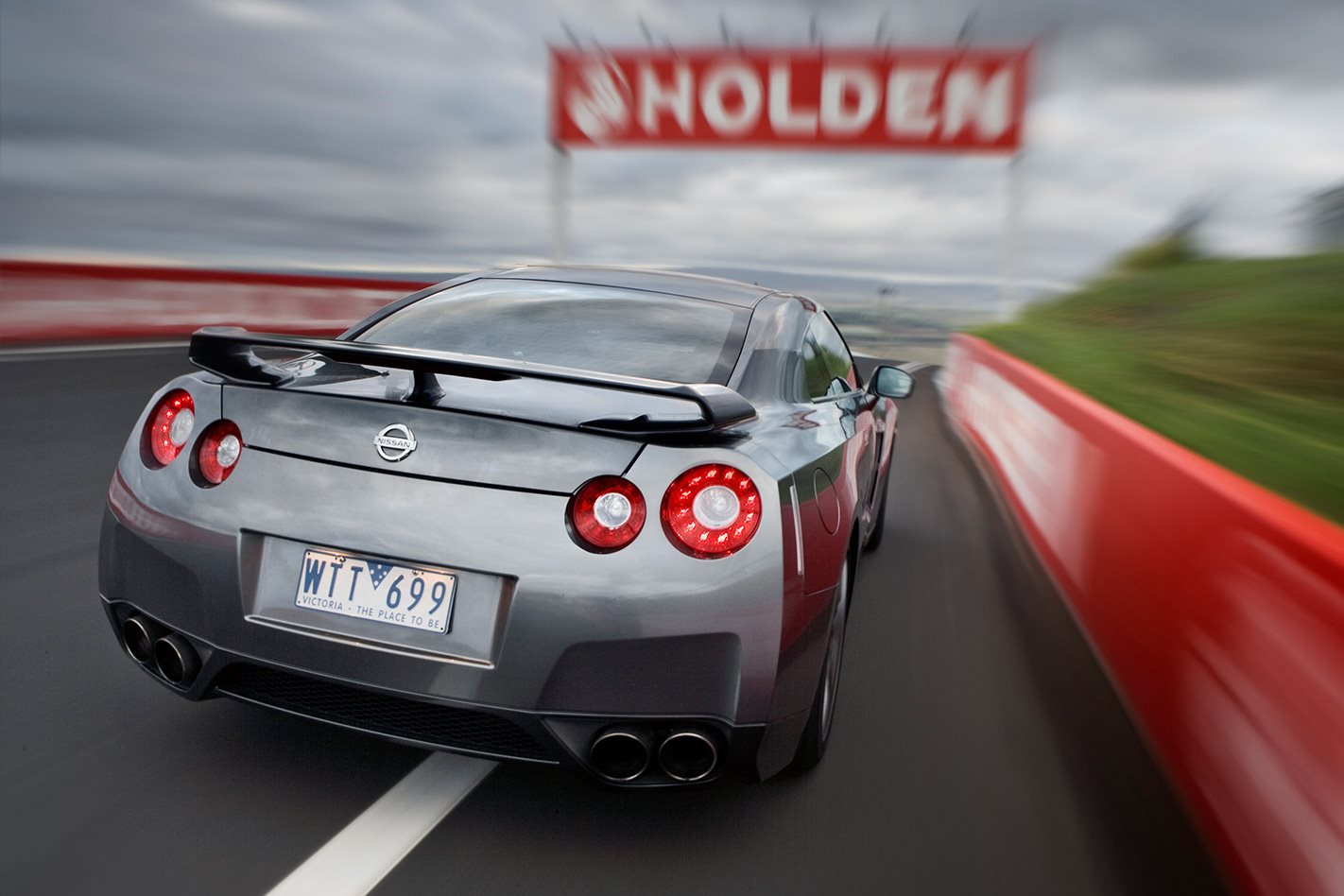Pretenders are uncovered ruthlessly in racing. Craftier, older heads exploit weaknesses the debutants never knew they had. Some grow into solid players and a rare few into stars.
This story was originally published in our March 2009 issue
But once in a generation, raw material, hard work and belligerence can transcend stardom to create something greater. They become legends.
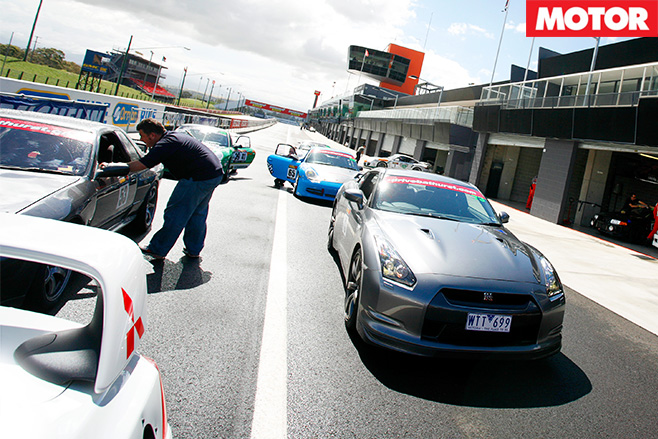
Now, nearly 20 years later, the same car maker has thrown up another bombshell with pretentions to greatness. And it has the same name.
It is, Luffy tells me, waiting in Pit Garage Eight. The key is in it, somewhere. This isn’t the first time we’ve driven it and, for sure, it’s not the first time you’ve read about it. There was Nissan’s long gestation period, including some lap times that Nissan’s benchmark, Porsche, found barely credible. And said so. Loudly.
Its numbers were widely known long before it debuted. Everybody knew of the 357kW and 588Nm its 3.8-litre, twin-turbo V6 punched out. Mechanical bits, too: Nissan told all and sundry about its all-wheel drive system, with its double-clutch gearbox, rear diff and transfer case cuddling together in a transaxle on top of the rear axle.
It has the latest in kooky diff technology and grip-maximising software, but Nissan rarely mentions the 1750kg it all has to launch and stop.
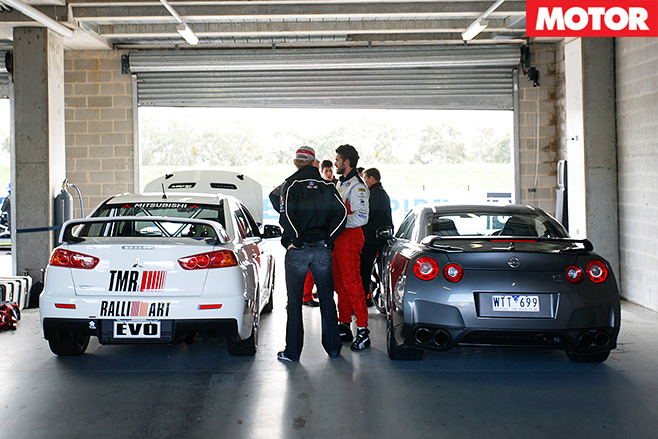
MOTOR has brought the GT-R to Mount Panorama and we’ve brought it here to go hard, not just to take pictures. We’re bringing the GT-R home.
Warren Luff and I won’t be alone, though. We’ll be sharing track space with a motley fleet of Porsches, Commodores, other Nissans, Lotuses and a confusing array of quick machines and quirky vintages. Plenty of them are stripped, striped and prepped for production-car racing, including GT2s, GT3 RSs, early GT-Rs, Subarus, Mitsubishis and HSVs.
Some of their drivers are curious. Some don’t think the fat road car should be here. Most expect to touch up the heavy, ugly machine with its road tyres and standard brakes and pads. Luff isn’t so sure. Worst-case scenario, all that grunt should keep them honest up the hill.
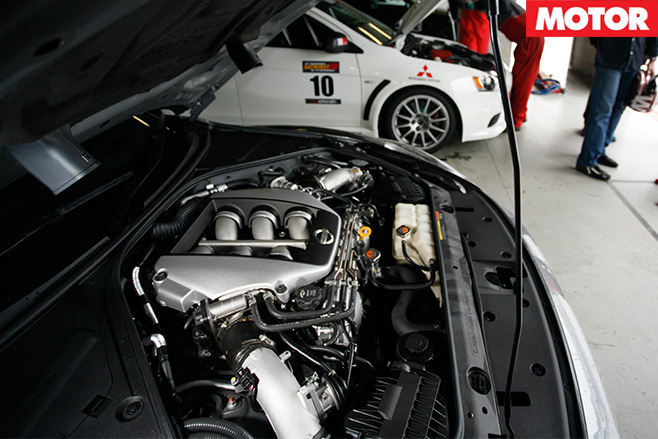
It qualified 11th, but got warmed up in the race, storming past the Cosworth Sierras, flicking aside BMW M3s and destroying the Holdens up the mountain, where their V8 torque was supposed to dominate. It didn’t matter that it broke, because its 2:15.46 wasn’t just the fastest lap of the race, it was the fastest race lap any touring car had ever posted. It would have been enough for fourth in qualifying.
It was dubbed ‘Godzilla’ and the name resonated around the world. It still does, but does it still deserve it? It doesn’t really sound like it when you fire it up. Fiddling around with the different computer screens, the gruff idle in the background doesn’t smack of supercar status, but the GT-R always went its own way.
All sharp angles, odd front quarter panel, monster round taillights and massive exhausts, it still does. Even sitting like this, it exudes the image of a fundamentally angry, purposeful, cranky car. It’s like it was treated badly as a kid and grew to like it.
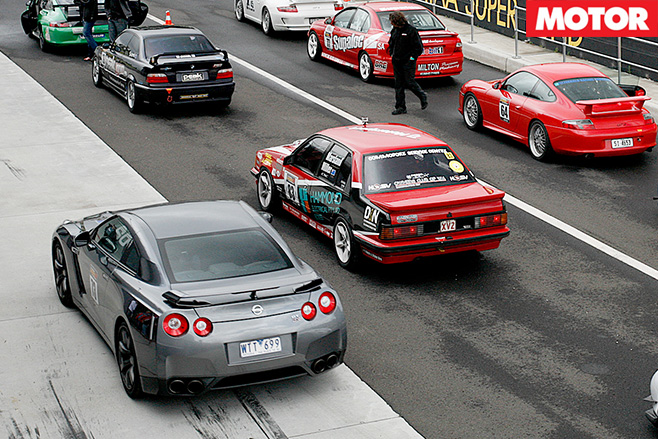
There is a fleet of benchmark Porsches here – most in race trim – so we might soon know, but the question nobody else has answered is whether or not you’d own one. It seems like good buying at $148,800, but it’s a big ask for a Nissan badge.
Compared to the other stuff in our group, it sits high and proud while the Porsche snouts sniff the braking zones. There are no lap times today – at least, not officially. They will be recorded so officials can sort the cars into speed groups, but we won’t know.
That’s no bad thing, and we’ve waited until all the quick jiggers have left pitlane before pulling the paddle into first to trickle onto Mountain Straight. It’s immediate. It’s still scary fast. There’s no place for a standing start, but the GT-R has grunted its way into third gear before the pit-exit ends, and it’s already streaking past 130km/h.
By the time it reaches the first crest, it’s already pulling 230 and into the braking zone the concrete gets real big, real quick. And this is the out lap. Jesus!
From Turn Two (Griffins Bend), it feels like its engine is arrogantly rejecting the entire notion of a Mountain being here. Its torque spread begins at idle and hits a plateau of 588Nm at 3200 revs and stays there. From the seat, it doesn’t feel like that at all. It feels like the thing builds up all the steam you’d ever need from about 1500rpm and never, ever lets go.
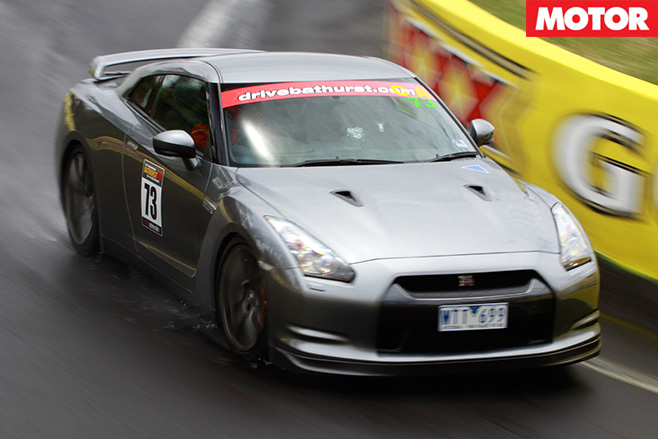
There’s little smoothness, but plenty of gruff bellowing from the V6 and the hiss of the turbos cramming air is what gets your attention. The right paddle gives fourth almost before the ripple strip ends, then you’re in fifth and then you realize something. Something important.
Race mode isn’t always the best mode on race tracks. Especially here. Most Race-type modes stiffen everything up. You don’t want that here. It’s squirming around on the suspension, walking sideways here and there up Mountain Straight, bump steering from one visually non-existent depression to the next. And then you hit the crest. At full speed.
It’s at full roar in fifth and, while you try to keep a bit to the left, it’s walking so much that you give it more margin for error and you steer for the middle. And then you notice something strange; the car’s off the ground. Almost.
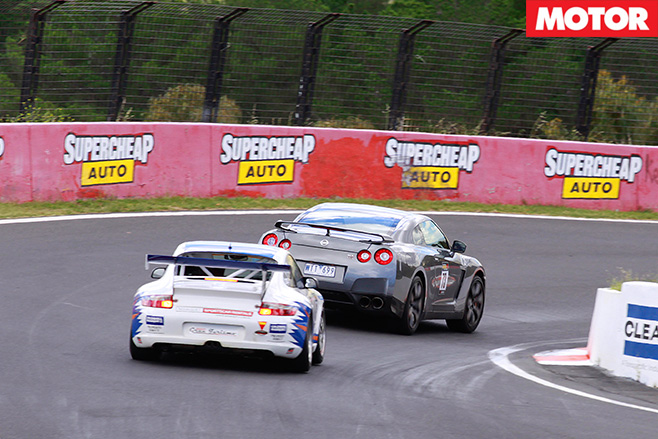
The needle’s snatching 250 before the braking zone – and that’s mostly because my jetlag is delivering overt prudence – but the brake pedal bites hard, the GT-R settles easily and it turns in hard.
The run up the mountain is something else. Already, we’re amongst the Porsches, and the GT3s can’t hang with the Nissan here. Unlike the Stuttgart stormers, there’s no glorious linear rise in the revs and the power delivery.
It slams hard early and keeps slamming at about the same rate until 7000rpm. It’s already in fifth again before The Cutting and it spits itself out of that steepest of pitches with a disturbing disdain for topography.
From there, the big Nissan builds more and more speed so that by the Reid Park gates, it’s already travelling fast enough to need to run all the way out to the concrete on the exit. Using all the track, the rollercoaster builds momentum until you come to the realisation that you need to back off and recalibrate. This GT-R is just that fast.
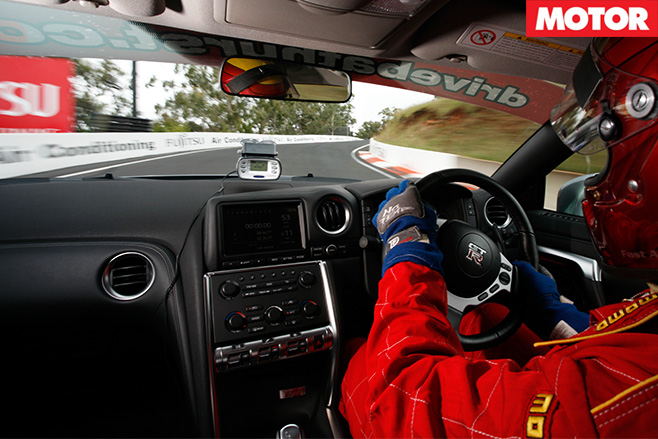
It’s here that you feel its weight slingshotted beyond normality until you have to ask it to do unnatural things coming back down again. It doesn’t feel terribly keen about any of this stuff now.
The blind approach to The Esses is okay, but the right hander makes the Nissan’s gizmos think and The Dipper downright confuses them, to the point where it won’t pick up the throttle at all until it’s travelled another 50 or 60 metres. That’s not so bad, though, because it refuses to deliver all the drive coming out of Forrest’s Elbow, and waits at least 150 metres before it pulls the trigger.
When it does, Conrod Straight never felt so short. It’s already doing 250 at the dip, it’s indicating 280 before The Chase (though prudence washes off 50km/h of that before attempting to turn in) and then there’s the big brake bite. It stops, but … then it reaches Murray’s Corner and it really doesn’t want to stop a second time.
And this is the biggest problem. By any measure, the Brembos are a decent size. There are six-piston calipers up front and four-piston monoblocs down the back, and all four rotors are 380mm, but on a track like this, they don’t feel like they’re enough.
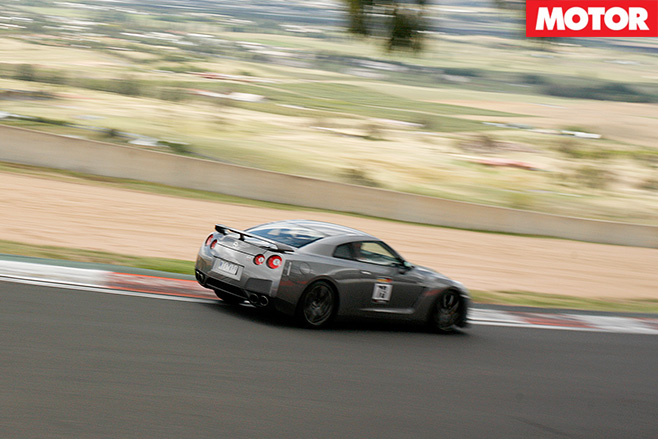
The problem isn’t stopping as such, because they keep climbing off the canvas to have another go. The real issue is feel and confidence, because they feel bad and inspire no-one. From Skyline onwards, the brake pedal is at a different height every time you go looking for it and it asks for a different pedal pressure to get the same jobs done.
For a straight-line shove, that’s not really a problem. Where it hurts is the little, confidence-settling pedal brushes that you need on a fast track like this one, or the small-but-critical bits of help a brake brush can give the steering when things get busy. If the same inputs can’t do the same job lap after lap, then the driver will lose confidence. Times will suffer.
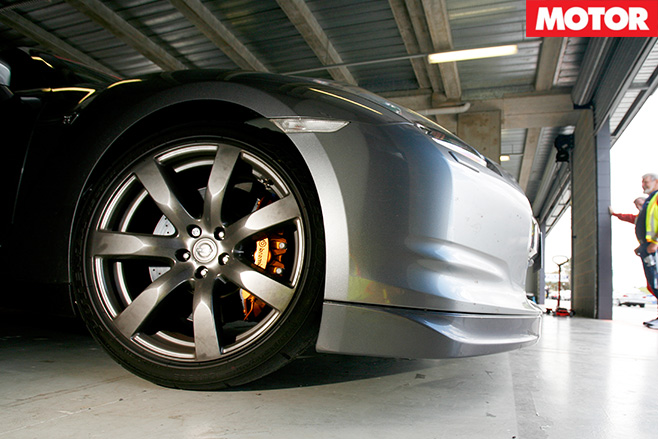
By The Cutting he’s already talking about the Nurburging lap. By the end of it, he’s set a new, but unofficial, production car lap record, though one that’s subsequently been beaten by German touring car ace Bernd Schneider in a Mercedes-AMG GT S.
A 2:25.60 isn’t going to give a V8 Supercar a hurry up, but it would have been good enough for this overweight, stock-standard road car to sit 28th on the grid for the 1992 Tooheys 1000. The R35 is no pretender.
Nissan GT-R Specs: Body: 2-door, 2+2-seat coupe Drive: all wheels Engine: 60-degree V6, DOHC, 24v, twin-turbochargers Material: alloy head/alloy block Bore/Stroke: 95.5 x 88.4mm Capacity: 3799cc Compression: 9.0:1 Power: 357kW @ 6400rpm Torque: 588Nm @ 3200-5200rpm Redline: 7000rpm Fuel/Tank: 98 octane/71 litres Kerb Weight: 1740kg Power-to-weight: 203kW/tonne Transmission: 6-speed dual-clutch Ratios: 4.05/2.30/1.60/1.25/1.00/0.80 Final Drive: 3.70 Suspension: double A-arms, coil springs, anti-roll bar (f); multi-links, coil springs, anti-roll bar (r) Length/Width/Height: 4655/1895/1370mm Wheelbase: 2780mm Tracks: (f/r) 1590/1600mm Steering: power rack and pinion Turning Circle: 10.4m Brakes: 380mm ventilated discs, six-piston calipers (f); 380mm ventilated discs, four-piston calipers (r); ABS, EBD, ESC Wheels: 20 x 9.5-inch (f), 20 x 10.5-inch (r); forged alloy Tyres: Bridgestone Potenza RE070R Size: 255/40R20 (f), 285/35R20 (r) Price: $148,800

